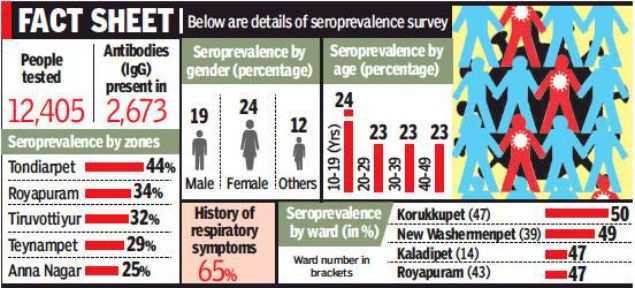
In July, the NIE collected blood samples from 12,405 people from 51 of the corporation’s 200 most populous districts. Of these, 2,673 had evidence of infection: their blood showed the presence of immunoglobulin G (IgG) antibodies.

The corporation estimates that as of mid-July, 17.66 lakh people out of a population of 82.16 lakh would have been infected.
The survey, however, showed that seroprevalence ranged from 7% in the Madhavaram area to 44.2% in Tondiarpet. Even across districts, 50% of residents sampled in Korukkupet in northern Chennai showed the presence of antibodies, against 25% in Saligramam and 8% in Mugalivakkam.
The corporation’s commissioner, G Prakash, said the survey had helped the civic body scientifically refocus its health interventions. “In areas where seroprevalence is high, the number of cases is gradually decreasing. We can see that they are achieving stability, ”he said, indicating that efforts would be intensified in areas where seroprevalence is lower.
The seroprevalence data also show that among those sampled, more women (24%) showed the presence of antibodies than men (19%).
Seroprevalence was as high as 65% among those with a history of respiratory symptoms. Among age groups, it was highest in the 10-19 age group and 40-49 age group and only 16% among those over 60.
Prakash indicated that since this was done in July, many more could have gained immunity since then and that the corporation would continue with more such polls.
The survey found that the ratio of actual infections (as seen in seroprevalence) to that of registered cases was lower compared to some published studies. This indicated high test performance, according to the study. Similarly, the infection mortality rate was comparable to or lower than in published studies.
The study has also indicated that it is necessary to understand why seroprevalence varies greatly between zones in order to improve control measures.
.